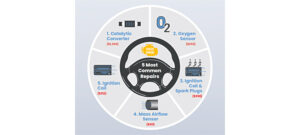Connectivity can help OEMs shift from a transactional relationship to ongoing monetization throughout the vehicle’s lifecycle
London—New vehicle sales contracted by 15 percent in 2020, a lower drop than initially anticipated given the dismal prospects in the third quarter of last year. Consumer enthusiasm began to recover at the end of 2020 and the first quarter of 2021, which caught carmakers and their suppliers by surprise.
Meanwhile, consumers have become more demanding about their in-vehicle infotainment expectations, driving strong interest in connected vehicles and boosting growth opportunities for the industry. ABI Research, a global tech market advisory firm, expects a 20 percent growth in connected vehicle sales in 2021 and a 10.4 percent CAGR between 2020 and 2026.
“Announcements such as the partnership between Hyundai and NVIDIA to standardize AI-based infotainment experience throughout its fleet, Mercedes’s MBUX Hyperscreen, BMW’s iDrive 8, and Tesla Model S with 10 teraflops of processing power for superior gaming experience demonstrate that the connected vehicle technologies that will shape the automotive industry in 2021 and beyond will be all around the infotainment systems,” said Maite Bezerra, research analyst at ABI Research.
“This will lead to opportunities for the whole ecosystem, but especially chipset providers, such as NVIDIA, Qualcomm, Xilinx, and NXP, offering powerful platforms to handle AI-based functionalities and headroom for OTA updates.”
Shipments of vehicles with connected infotainment will grow by 23 percent in 2021, returning to pre-pandemic levels, led by increased penetration in emerging market regions.
The recently announced partnership between Ford and Google shows a considerable migration to Android OS, which will see more than doubled penetration in production vehicles by 2023 and 2024.
The closer proximity between carmakers and Google, unthinkable a few years ago, is a response to the poor reviews of embedded systems and still high dominance of smartphone projection.
“Nevertheless, because of the quicker than expected demand recovery, the automotive industry has a significant challenge to overcome in 2021,” said Bezerra.
Due to the auto factories shut down last year, semiconductor companies shifted their production to other markets to compensate for the missing revenue. With lifting in restrictions, consumer demand bounced back faster than expected.
Carmakers have increased production to meet the demand. However, as semiconductor companies did not immediately switch their factories back to automotive-grade chips, they could not fulfill orders on time, forcing OEMs to cut back production due to missing parts. Supply disruption, which is likely to be solved by the end of the year, will delay sales of connected vehicles in the first quarters of 2021 but should have a mild effect on the annual sales.
While the connected vehicle subscription model has not proved profitable yet, sensor data marketplaces, OTA updates, and in-vehicle commerce are examples of how connectivity can help OEMs shift from a transactional relationship to ongoing monetization throughout the vehicle’s lifecycle.
“However, to realize those opportunities’ potential, OEMs must offer a more compelling user experience than smartphone mirroring to increase touchpoints with their embedded systems. Tesla, Mercedes-Benz, Volvo/Polestar, Harman, Visteon, and Aptiv are examples of OEMs and Tier Ones heavily investing in differentiation,” Bezerra said.







Comments are closed.